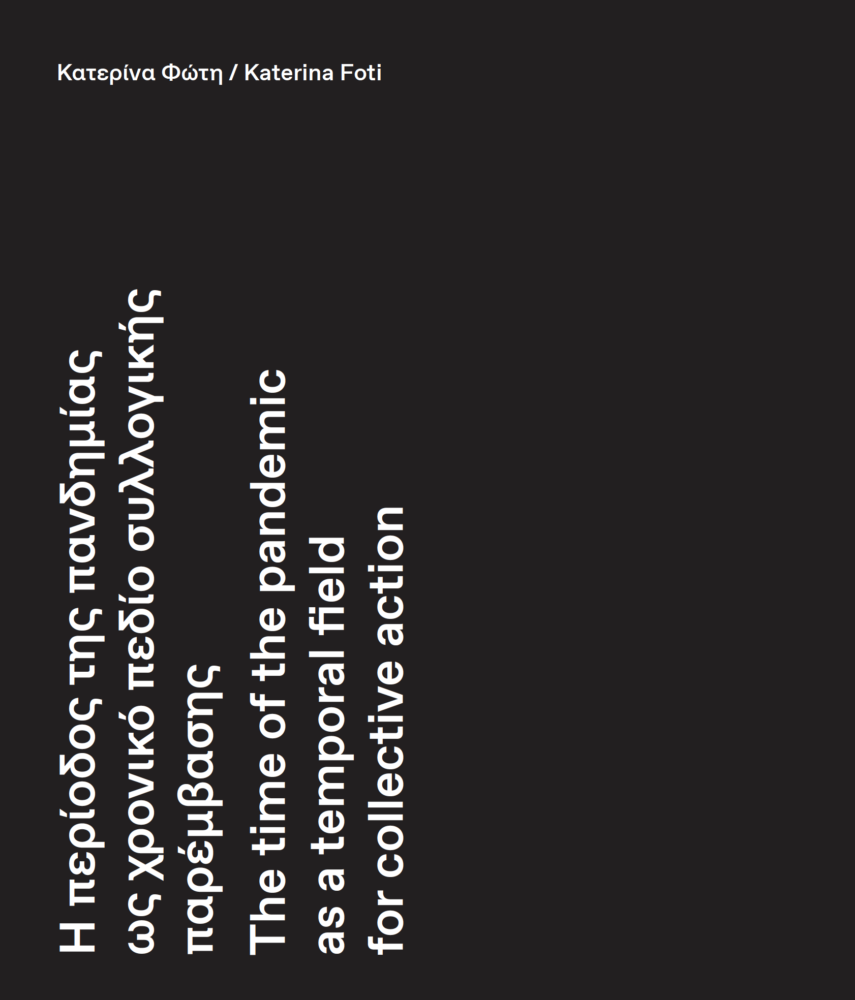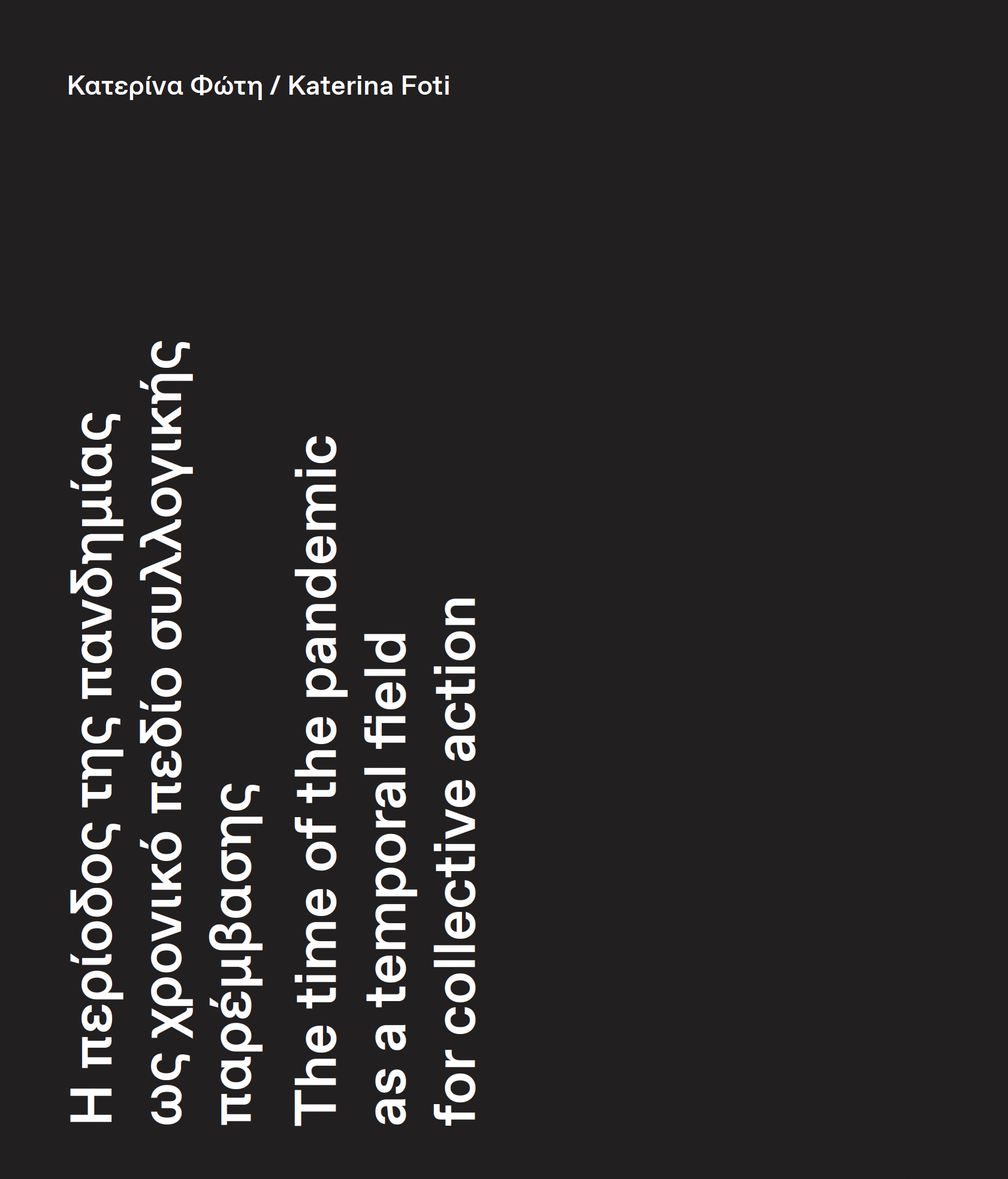ΤHE TIME OF THE PANDEMIC AS A TEMPORAL FIELD FOR COLLECTIVE ACTION.

The pandemic caught culture in a state of extreme bewilderment, as it vividly revealed the chronic difficulties which, for years now, had been ailing various professions in the cultural sector: unpaid work, absence of social/health insurance and of governmental provisions; lack of control over employers; lobbying; a culture nurturing controlling behaviours, deep-rooted patriarchy and masterly authority; and, ultimately, an official —and not only— conception of art as a hobby rather than a profession and a field within which violence is mysteriously and inextricably linked to success. At the same time, however, precisely because this framework had to be acknowledged for what it was, the pandemic threw collective action and solidarity back into the mix and in fact turned them into an imperative. It thus became clear that through the creation of egalitarian and inclusive communities and collectivities artists would be able to raise their voices against precariousness and insecurity and overcome the adversities brought to the surface by the pandemic.
For years now, art workers have had to work under conditions which are far from transparent. For many professionals, their area of specialisation is not even assigned an activity code number in the national insurance system, while employment contracts are predominantly fixed-term with some art workers being compensated on a daily-wage basis (more commonly so in the performing arts sector). It has been established that artists and art workers are often forced to agree to payments that do not correspond to their actual working hours and, moreover, exclude any kind of health insurance coverage —which is often sacrificed in the interest of securing basic monthly expenses and continuing to receive unemployment benefits. At the same time, even professionals who are regularly insured by their employers are often declared under different professional capacities, thus ending up being excluded from state benefits and other kinds of support schemes. In addition, a large number of professionals in the cultural sector are considered secondary education graduates, as their schools are categorised as ‘higher vocational’ and not ‘higher education’ institutions. As a result, based on their degree qualifications they are classified as basic salary earners, therefore amplifying the tendency towards a discrepancy between work and pay in the cultural sector.
In a work environment where, for years now, workers have been stretched to their limit, the pandemic and the digital shift have created the conditions for further exploitation: this time, it was copyright and related rights that came under attack. Many producers using live streaming and on-demand services to reach audiences tried to unlawfully include copyright fees in the compensation already paid to contributors. This is a direct infringement of copyright law, based on which any permission to use copyrighted material is granted for a single performance, while employers can by no means secure unlimited access to show the work at any time and space of their choice on the grounds of having disbursed a one-off payment to contributing artists. The commercial exploitation of the produced work leads to the generation of profit and contributing artists are legally entitled to compensation, which may by no means be substituted by the full and complete payment received for work or services rendered.
In this context, and given the state’s disregard for the cultural sector as well as the fact that culture was among the branches of the economy most heavily affected by the pandemic, art workers responded collectively and en masse, much to the surprise of the artists themselves who had long been accustomed to considering individual action as the main option available to them. For me, the greatest gain from this period is the fact that artists returned to the unions and sought out collective action. In a time when all public discourse has been urging people to social distance, the webs and networks promoting solidarity, inclusion and participation managed to come out stronger despite being limited to the digital world. To be sure, soon enough the momentum also reached the real world, with important actions and protests being organized within the public sphere of every subject perceiving oneself as a member of society. In other words, we raised a strong, militant, active and collective voice, managed to secure a great deal to help us weather the pandemic and understood that even though we have a long journey ahead of us, if we decide to walk side-by-side there is a lot more to gain than if we marched along the road as lonely travelers.
Since the beginning of the pandemic, artist-led actions have been the most numerous and most widely attended in recent years. Also significant is the fact that several actions envisaged the reappropriation of public spaces, thus engaging the civil society in an organic dialogue with art and bringing it into direct contact with the problems the cultural sector —the primary victim of the successive lockdowns— is currently facing. From the flash mobs at Dionysiou Areopagitou street, to the ‘protest ballet’ recently performed by dance students outside the Greek Ministry of Culture, it is clear that artists have managed to express themselves politically through a plurality of actions, but also invent new ways of gaining visibility and of communicating with the public. Crucial also were the unprecedented participation rates recorded during artist union general assembly meetings in the past year, whether these were held online or live while adhering to Covid-19 health protocols. Finally, another important development is that artists chose to support wider social issues by actively and meaningfully participating in actions related to democratic rights, standing in solidarity with doctors and healthcare workers and taking part in general strikes, thus lining up with everyone affected by the pandemic and engaging with all kinds of problems faced by all members of society.
It is hard to predict with any degree of certainty what the future holds in store for culture, but what is certain is that we rallied together and aligned ourselves with our colleagues and with the people around us. The pandemic caught us at a state when we had ‘nothing to lose but our chains’. Armed, then, with our determination to act collectively and promote mutual support, the days after the pandemic will find us fighting for our rights, creating but also standing by each other and all those in need. Because art needs a crowd, and we are thousands.

*Katerina Foti is a lawyer, Legal Consultant of SEHOHO (Union of Workers in the Dance Industry), dancer and choreographer.
***Τhis text was part of the 2nd publication of ARTWORKS that reflects the SNF Artist Fellowship Program 2019-2020.


